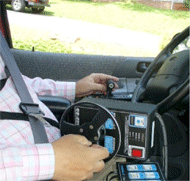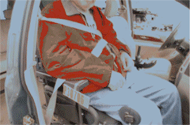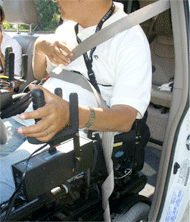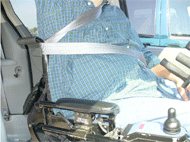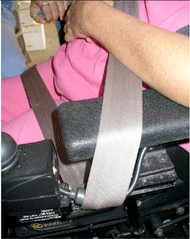Safety System and Usability Issues for Wheelchair-Seated Drivers and Passengers of Private Vehicles: A Pilot Study
Linda van Roosmalen PhD1 , Ilona de Jongh BS2 ,
Nichole Ritchie MS3 and Lawrence W. Schneider, PhD3
1 Deptartment of Rehabilitation Science and Technology, University of Pittsburgh, Pittsburgh, PA
2 Industrial Design Engineering, Delft University of Technology, Delft, The Netherlands
3 University of Michigan Transportation Research Institute, Ann Arbor, MI
ABSTRACT
Sixteen wheelchair-seated drivers and five front-row wheelchair-seated passengers were observed while preparing for travel in their private vehicles. Once in position for travel, each participant was questioned on their sense of transportation safety, usability and independence. Problems with proper seatbelt use and fit were due, in most parts, to interference by wheelchair components, such as armrests or due to the lack of a usable and available seatbelt system. Drivers also commented on the importance of maintaining postural balance during driving and expressed problems with independently exiting their vehicles in case of an emergency or power failure due to an inability to operate the switch that releases the wheelchair from the docking-type securement device. Results of this study will be used to guide the development of future standards and to develop improved occupant restraint and wheelchair systems that enhance the safety and independence of wheelchair- seated drivers and passengers of private vehicles.
KEYWORDS
Wheelchair transportation, safety, driving, occupant restraints, seat belts
BACKGROUND
In the United States, nearly 1.7 million people use wheelchairs for daily mobility needs (1). For 80% of wheelchair users, public transportation is not a feasible means of transportation (1). Transportation in a (private) motor vehicle provides a sense of independence and freedom and according to the Bureau of Transportation Statistics’ Omnibus Survey, 83% of adults with disabilities ride or drive in a private vehicle (2). In 2000, a study conducted by the National Highway Traffic Safety Administration showed that the majority of private vehicles modified for accessibility were full-sized vans and mini-vans (3). This study also concluded that accessibility modifications were made more frequently for drivers than for passengers. Significant safety issues exist for wheelchair-seated drivers and passengers, as wheelchairs are primarily constructed to be a mobility device and not necessarily designed for use as seats in motor vehicles. A step in the right direction to improve transportation safety for wheelchair-seated travelers was the completion of ANSI/RESNA-WC19/Volume 1, a voluntary standard for wheelchairs used as seats in motor vehicles. This standard has been recognized by an increasing number of wheelchair manufacturers and wheelchair tiedown and occupant restraint manufacturers. However, the WC19 standard does not particularly benefit wheelchair-seated drivers who must use docking-type securement systems and for whom seatbelts must fit properly without the assistance of another person. Current 4-point belt-type tie-downs are not designed for independent use, and buckling up and releasing belt-type occupant restraints is difficult for most wheelchair-seated individuals (6).
STUDY OBJECTIVE
The objective of this study was to observe and document safety and usability issues of drivers and passengers seated in their wheelchairs in the front row of private vehicles. The primary focus of this study is on the use and positioning of seatbelt restraint systems and on identifying those factors, such as vehicle interior, vehicle controls and wheelchair components that interfere with the proper use and fit of lap and shoulder restraints.
METHOD
Data were collected for 21 individuals who drive or travel as front-row passengers in private vehicles while seated in their wheelchairs. Participants were recruited from the western Pennsylvania (n=12) and southeastern Michigan areas (n=9). Individuals traveling in the second row of the vehicle or those individuals who transfer into a motor vehicle seat were excluded from the study. Subjects were observed, videotaped and/or photographed while entering and exiting, their vehicle, moving into and out of the driver or right-front passenger position, and getting ready for travel or for exiting the vehicle by position or releasing, or having someone else position or release, available lap and/or shoulder restraints. Once in position and ready for travel, the subject was questioned with regard to the specific features of their vehicle, wheelchairs, and restraint systems relative to motor vehicle transportation, and to determine their perceptions of vehicle safety, usability and travel independence.
RESULTS
To date, 21 subjects have been recruited and tested, including five wheelchair-seated front-row passengers and 16 wheelchair-seated drivers. Two of these subjects (both drivers) used manual wheelchairs with power assist features, and the remaining 19 subjects were using powered wheelchairs. The average age of passengers is 66 years (n=5) and the average age of drivers is 47.4 years (n=16). Subjects had been using wheelchairs for an average of 20.1 years. On average, drivers had used private vehicles while seated in their wheelchairs for 15.8 years and passengers had traveled while seated in their wheelchairs for an average of 7.8 years.
The first column of Table 1 lists the vans and minivans used by wheelchair seated drivers and passengers, as well as the mode of entry (lift or ramp), and the status of a frontal-impact airbag for the wheelchair occupant. Three subjects accessed their vehicle by means of a lift and 18 subjects used a ramp. On average, drivers indicated that they operate their vehicle about 5.4 days per week and about 1.3 hours per day.
| Vehicle make and model | Drivers | Passengers | Lift | Ramp | Airbag removed or off |
|---|---|---|---|---|---|
Chevrolet Uplander |
1 |
|
|
1 |
|
Chevrolet Venture |
|
1 |
|
1 |
|
Chrysler Town & Country (Entervan) |
2 |
1 |
|
3 |
1 |
Dodge Caravan (Entervan) |
2 |
1 |
|
3 |
|
Dodge Grand Caravan |
2 |
1 |
|
3 |
1(off) |
Ford Econoline |
2 |
|
2 |
|
1 |
Ford Winstar |
1 |
1 |
|
2 |
|
Plymouth Montana |
1 |
|
|
1 |
|
Toyota Sienna |
5 |
|
1 |
4 |
|
Maneuvering in Vehicles and Securing Wheelchairs
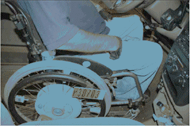 Wheelchair-seated driver without a seat belt
Wheelchair-seated driver without a seat belt
Wheelchair-seated driver using only a shoulder belt and no pelvic belt.
Poor restraint positioning on a wheelchair seated passenger. Restraint runs over the wheelchair armrests and high over the abdomen
Poor restraint positioning on a wheelchair seated driver. Restraint runs over the wheelchair armrests and high over the abdomen.
Wheelchair-seated driver shows how his shoulder belt hooks around the wheelchair back cane.
Wheelchair-seated passenger loops the pelvic and shoulder belt around the wheelchair armrest.
Figure 1: Examples of improper and non-use of occupant restraints (Click for larger view)
Most vehicles allow sufficient wheelchair maneuvering space between the entry point and the wheelchair station, but most subjects needed several attempts to maneuver their wheelchair into position for docking securement or for securement by a caregiver. Seventeen subjects, including all 16 drivers and one passenger, used automated docking-type securement systems (EZ-lock or Q’Straint Dock ‘N Lock). The wheelchairs of passengers were secured by their caregiver using a 4-point strap-type tiedown. One subject was awaiting delivery of a securement system and had been driving with the wheelchair unsecured. Most drivers reported they are unable to manually operate or reach the manual release of their docking securement system for egress during an emergency or loss of vehicle power and they therefore rely on their cell phones to ask for help.
Most subjects indicated that they felt safe to very safe when driving their vehicle and when entering and exiting their vehicle. When getting positioned in the vehicle, most wheelchair users with powered seating systems would adjust their seating systems or leg rests to prevent their legs and feet from contacting the instrumentation panel and to achieve a suitable posture and position for travel.
Use of Vehicle Safety Systems
Only four of the 21 subjects were using non-modified original equipment manufacturer (OEM) vehicle restraints. The other 17 vehicles were equipped with after market seat belt systems or modified OEM seatbelts. Only nine subjects used a wheelchair-mounted headrest during travel. Investigators observed poor seatbelt fit in many cases; pelvic restraints were routed over the armrests, high over the abdomen or not used at all (Figure 1). Shoulder belts, when used, were sometimes routed off the shoulder, or used without a pelvic belt. Two subjects hooked their seatbelt around the wheelchair armrest structure or around the push handles of the wheelchair instead of buckling their seatbelt latch plate into the receiver (Figure 1). Several subjects indicated that their occupant restraint interfered with their wheelchair (n=10) or components on their wheelchair. Four subjects indicated that proper placement of their occupant restraint interfered with their vehicle controls. In addition, drivers and caregivers of passengers reported problems operating and reaching seatbelts, resulting in non-use or misuse of seatbelts for eight of sixteen drivers.
The wheelchairs of nine subjects included a wheelchair-mounted headrest. The vehicles of two subjects did not have frontal-impact airbags and one subject had had their airbag disconnected. Eight subjects were using some type of pelvic postural support during travel, and six drivers reported using a chest strap during travel. Nine subjects used some type of lateral support to assist them with balance when driving from their wheelchair.
Furthermore, subjects that drive have difficulty operating and reaching occupant restraints, resulting in non-use or misuse of restraint systems in eight of sixteen wheelchair seated drivers. On average, respondents indicated that the usability, safety, and independent use of restraints could be improved. And both passengers and drivers thought it important to have an effective occupant restraint system. However, in contrast to the observations of poor seatbelt fit and lack of seatbelt use by many subjects, most subjects reported feeling safe to very safe when traveling in both rural and urban areas, while six subjects thought that their safety in the vehicle could be improved.
In addition, investigators observed poor belt fit in many cases; pelvic restraints were routed over the armrests, high over the abdomen or not used at all (Figure 2). Shoulder restraints, when used, were in some cases routed off the shoulder, or used without a pelvic restraint. Two subjects chose to hook the restraint around the armrest or seatback cane instead of buckling their seatbelt latch plate into the receiver. Ten subjects reported that they feel “safe” to “very safe” when rating driver safety and six subjects think that their safety in the vehicle “could be better”. On average passengers and drivers find it important to have an effective occupant restraint. When asking subjects what improvements could be made to their restraint system, subjects mentioned automatic, drive-in style (passive) occupant restraint systems and adjustable anchor points. Table 2 summarizes subject responses on what additional restraint improvements could be made.
A harness could be better for keeping balance. |
A passive restraint system would be preferred, or an automatic moving top shoulder belt anchor |
A height adjustable upper anchor point. And adjustable belt tension so that it doesn't retract when you recline in your wheelchair during travel (passenger). |
The belt gets twisted. I want it more within reach. |
Move the anchor points so they are more accessible. |
Change the postural support to give me more stability during driving. |
I would design the armrest to be open to allow for the seatbelts. I would have a drive in system. You drive into the lap belt and than you push a switch/control that tightens the belt. |
I would have a higher buckle post so that I don't have to lift the belt up and over my knees when I drive in. |
I would want a drive-in system. It adjusts up and at the pelvis. It allows for pressure relief during the ride. |
I would like a restraint bolted to the ceiling and that had no play. |
I want a system like they use in amusement park rides. A bar comes down and restrains you. It can be mounted on the wheelchair. |
I would in addition to my shoulder belt use a lap belt that connects to the pin connector on my latch plate. |
Mounts so that it doesn't prevent my arm from reaching the controls. |
Have more adjustment on position of lower stalk or move it further back and to the left. |
Ideal occupant restraint system would be waiting out of the way while he enters the station. Then on the push of a button, the belts or harness would retract to a position and tension recorded in memory. |
Passive system would be preferred. |
Would like snug fitting occupant restraint with a locking retractor to help hold passenger upright. |
Move seatbelt closer (further forward) so it's easier to reach, inboard buckle on hard stalk so it doesn't fall. |
Move seatbelt closer to wheelchair so it's easier to reach. |
CONCLUSIONS AND DISCUSSION
Safety and usage issues for wheelchair-seated drivers and passengers in private vehicles were assessed. Interference of wheelchair frames with occupant restraints, the vehicle interior and control systems were frequently observed. An inability to reach and operate seat belts and the unavailability of head restraints was often reported by subjects. As a result, seat belts are often misused, routed over armrests, or around clothing guards, or are not used at all. Another restraint issue observed and mentioned by subjects is that the seat belt tension is often too loose to provide effective postural support during driving. Postural instability can be aggravated by a bump in the road, an unexpected swerve or turn, resulting in an ineffectively restrained wheelchair occupant projecting sideways over the wheelchair armrest. In response to this need for postural support, two wheelchair seated drivers had made adjustments to their seatbelt system despite the fact that these adjustments could adversely affect the safety of their seatbelt system. Although wheelchair-seated drivers and passengers were often using improperly and poorly positioned and incomplete belt restraints and reported being unable to independently exit their vehicle in an emergency situation, most respondents reported feeling safe when driving or riding in their vehicles. Nevertheless, the observations made in this study, coupled with knowledge of what is required for effective occupant restraint and crash protection, have made it clear that improvements in seatbelt systems for wheelchair seated riders in private vehicles are badly needed. These improvements require not only innovative designs in passive (automatic) seatbelt systems but changes in the design of wheelchairs to reduce interference with proper seatbelt fit.
 Figure 2: Tri-pin on steering wheel posing potential injury hazard in the event of a frontal crash (Click for larger view)
Figure 2: Tri-pin on steering wheel posing potential injury hazard in the event of a frontal crash (Click for larger view) Although this study only focused on the safety systems on board the vehicle, additional results are being analyzed to evaluate the safety of steering controls such as tri-pins (Figure 2) and the safety of individuals that use adaptive control systems requiring removal of the airbag.
Study limitations include that vehicles of the majority of subjects were the products of only a few van modifiers. Including additional subjects that have vehicles from other van modifiers may result in additional problems and issues.
Study results will provide qualitative information needed to improve wheelchair design, the vehicle environment, safety systems, and driving controls to enhance the actual (not perceived!) safety, usability, and independence of wheelchair users in private vehicle environments.
REFERENCES
- Kaye, H. S., Kang, T. and LaPlante, M.P. Mobility Device Use in the United States. National Institute on Disability and Rehabilitation Research. Washington, D.C.: U.S. Department of Education, 2000. p. 14.
- U.S. Department of Transportation, Bureau of Transportation Statistics. Omnibus Household Survey. 2002.
- Cowen, Amanda. Common Vehicle Modifications for Persons with Disabilities. Research Note. 2002. Accessed: November 06 , 2007. http://www.nhtsa.dot.gov/cars/rules/adaptive/BTSRN/ResearchNote0209.html.
- Bertocci, G.E., Evans, J. Injury risk assessment of wheelchair occupant restraint systems in a frontal crash: a case for integrated restraints. J. of Rehabilitation Research and Development, Vol. 37-5, 2000, pp. 573-589.
- ANSI/RESNA. ANSI/RESNA WC-19: Wheelchairs Used as Seats in Motor Vehicles. American National Standards Institute (ANSI)/RESNA. Arlington, VA. 2001.
- Reed, M, Van Roosmalen, L. A pilot study of a method for assessing the reach capability of wheelchair users for safety belt design. 5, 2005, Applied Ergonomics, Vol. 36, pp. 523-528.
ACKNOWLEDGEMENTS
The RERC on Wheelchair Transportation Safety is funded by the National Institute on Disability and Rehabilitation Research (NIDRR), Department of Education, Washington, D.C., Grant # H133E060064. The opinions expressed herein are those of the authors and are not necessarily reflective of NIDRR opinions.
Linda van Roosmalen, Department of Rehabilitation Science and Technology, 2310 Jane Street, Suite 1300. Pittsburgh, PA 15203. 412 586-6911 Lvanroos@pitt.edu
